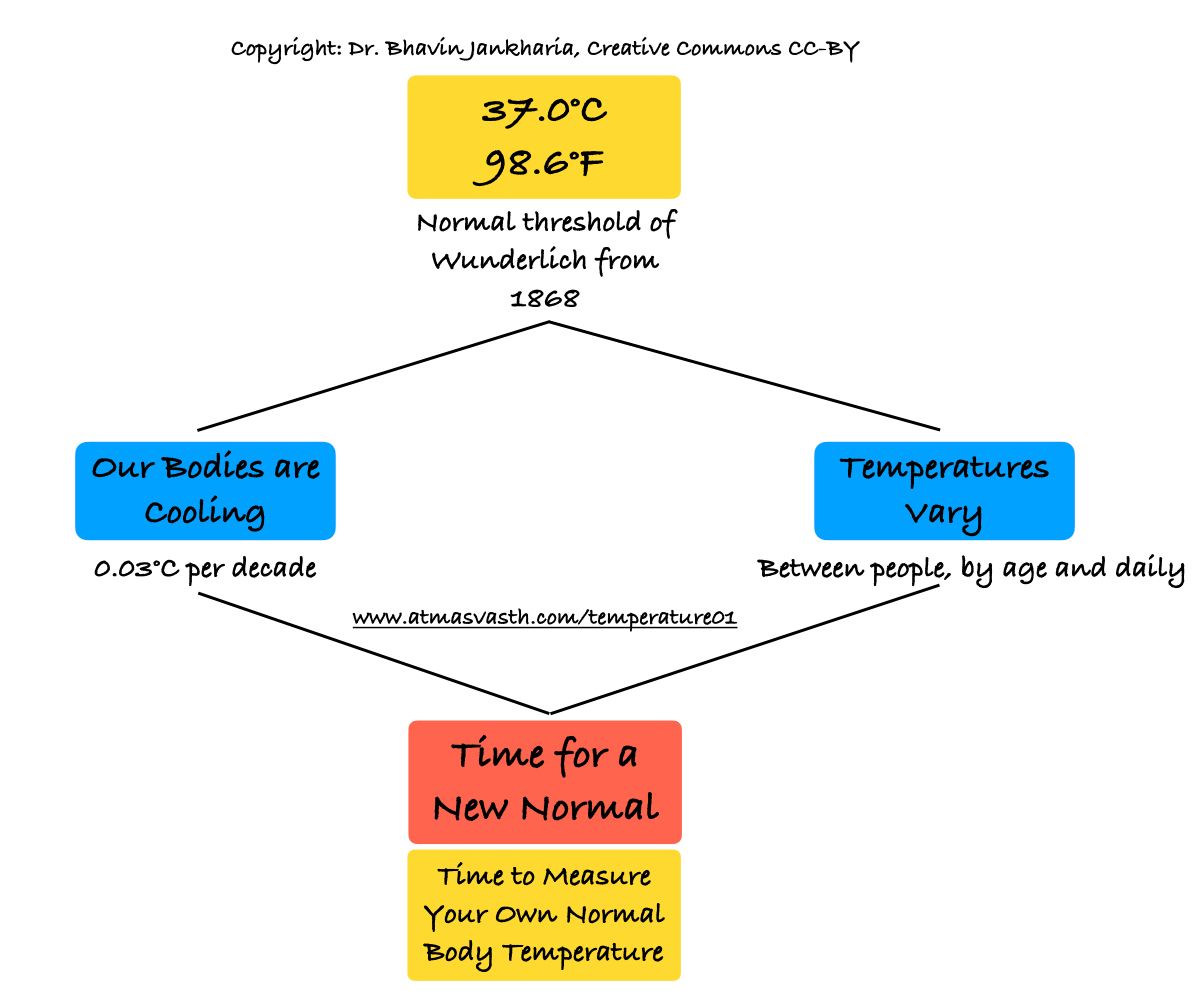The 37°C (98.6°F) Relic - It is Time for a New Individual Normal
Our bodies are cooling and most of our have normal temperatures lower than 37.0°C or 98.6°F

Measuring temperature is fundamental to the practice of medicine, something you can do on your own, akin to placing a finger on your pulse or measuring your blood pressure. Most of you would know how and when to use a mercury or digital thermometer, especially after the back of your hand feels warm or hot against your or someone else’s forehead.
Humanity has but three great enemies: fever, famine, and war; of these by far the greatest, by far the most terrible, is fever.
William Osler
Fever is a ubiquitous symptom and sign of disease, used to diagnose and treat illnesses in all branches of traditional and modern medicine.
As far back as the 10th century BCE, the Persian physician Akhawayni [1] documented the first fever charts. The Sushruta Samhita, written around the 6th century BCE, though primarily a surgical book, also discussed fever [2]. Galen around 100-200 CE believed fever to be a disease by itself, rather than a symptom and this thought dominated medical practice for over 1000 years [1].
The first air thermometers, called thermoscopes, were invented in the 16th century by Santorio who measured the temperature of the air expelled from the mouth. Galileo refined the process. After many decades of improvements and advances, Daniel Gabriel Fahrenheit in the early 1700s invented the famous scale that we still use today, especially in India. Anders Celsius around the same time created the centesimal scale [3].
Measuring the temperature of a patient to monitor clinical status quickly became standard practice. Carl Wunderlich in 1868 published his monumental paper that established the normal level of body temperature at 37°C (Celsius) or 98.6°F (Fahrenheit) and the upper limit of normal at 38°C (100.4°F) and along with other physicians at the time proposed quite rightly that fever is the symptom of a disease and not a disease by itself [3].
And just like that, Wunderlich’s normal body temperature numbers of 37°C or 98.6°F [3] became dogma, and a “universal truth”. You would think that over the last 150 plus years, some more work would have been done on such a fundamental definition of normal, if nothing else, then to just replicate his findings…but while more than 220,000 papers on COVID-19 have been published till date in the last two years, the number of prospective studies in the English language over 82 years from 1935 to Dec 2017, that have looked at normal temperatures in healthy individuals, is just 36 [4] with oral temperature measurements in just 5257 people. This review by Ivayla Geneva and colleagues found a lower median normal temperature of 36.5°C (97.7°F), with a normal range of 35.73°C (96.31°F) to 37.41°C (99.34°F). It also found that older people had an average 0.23°C lower temperature than the young.
More recently in a paper published in 2021, Adele Diamond and colleagues [5] looked at temperature measurements over 14 days in 96 individuals in Vancouver, Canada and found the mean temperature to be 36.1°C (97.0°F) with a normal range of 35.2°C (95.40°F) - 37.4°C (99.3°F). A study from Pakistan (India has no such study, though you would think it would be so easy to do) in 200 normal people found a range from 97°F (36.1°C) to 99.8°F (37.66°F) [6].
Couples often bicker about the setting of the air-conditioner or fan at night partly because of different body temperatures. If that is true, then how can a single number define normal temperature across all of humankind? [7]. Body temperatures vary across the lifespan of a single individual, among different individuals and during the day in the same individual. A 2017 study from the UK analysed data from the electronic health records of 35488 patients who had not received a diagnosis of infection or been given antibiotics and showed significant body temperature variability across individuals and different patient groups [7], concluding that we can’t really use a single number as normal…which in any case is too high, as we have already seen.
That is not all. There is also evidence that human temperatures are cooling with each passing decade, one study [8] demonstrating a 0.03°C reduction per decade over 157 years in the US. The reasons may be multifactorial, but the lower body temperature implies a lower basal metabolic rate, which in turn is associated with increased healthspan and lifespan. Obviously, then the so-called “normal” is much more dynamic than the single static number of 37°C (98.6°F) that we have been using for the last 150 plus years. To prove that this cooling of our bodies is not just an American, high-income country phenomenon, a study in a low socio-economic setting in tropical Bolivia, in a population prone to infections also showed that the average body temperature had reduced from 37.5°C to 36.5°C over two decades between the early 2000s to 2018. This cooling paralleled improved lifespans suggesting that declining body temperatures may be linked to improved living conditions and a reduced rate of infection and inflammation, though the authors are not absolutely sure of the exact explanation [9].

What are the implications? If your normal body temperature is lower than 37°C (98.6°F), then mild fevers may be missed and if your normal body temperature is higher than 37°C (98.6°F), you might be diagnosed with fever, even if you are completely healthy.
At a fundamental level, the definition of “fever”, especially when mild, gets called into question, when we don’t even know what “normal” really means. Just as with vitamin B12 levels globally and vitamin D levels in India, establishing normal values is of paramount importance if we want to define deficiency or disease accurately.
What does this mean for you and I? In our atmasvasth quest to live long, healthy, it is a good idea to measure our own temperatures at regular intervals when we are healthy, so as to understand our own “normal”.
Footnotes
1. Wright WF, Auwaerter PG. Fever and Fever of Unknown Origin: Review, Recent Advances, and Lingering Dogma. Open Forum Infect Dis. 2020 May 2;7(5):
2. https://rarebooksocietyofindia.org/book_archive/Sushruta%20Samhita%201.pdf
3. Wright WF, Mackowiak PA. Origin, Evolution and Clinical Application of the Thermometer. Am J Med Sci. 2016 May;351(5):526-34.
4. Geneva II et al. Normal Body Temperature: A Systematic Review. Open Forum Infect Dis. 2019 Apr 9;6(4):
5. Diamond A et al. One size does not fit all: Assuming the same normal body temperature for everyone is not justified. PLoS One. 2021 Feb 3;16(2):e0245257.
6. Adhi M et al. Range for normal body temperature in the general population of Pakistan. J Pak Med Assoc. 2008 Oct;58(10):580-4.
7. Obermeyer Z et al. Individual differences in normal body temperature: longitudinal big data analysis of patient records. BMJ. 2017 Dec 13;359:j5468.
8. Protsiv M et al. Decreasing human body temperature in the United States since the industrial revolution. Elife. 2020 Jan 7;9:e49555.
9. Gurven M et al. Rapidly declining body temperature in a tropical human population. Sci Adv. 2020 Oct 28;6(44):eabc6599.
Last Week

Atmasvasth Newsletter
Join the newsletter to receive the latest updates in your inbox.

